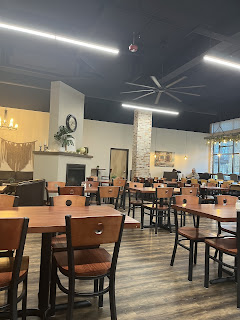Scooter’s Coffee & Wilder
After a long day playing with the Muscatine Symphony (we love a dress rehearsal & concert on the same day…), both Martin and I were too exhausted this morning to make our usual breakfast & coffee. We decided to try out a new coffee spot on our way to check on a friend’s cats: Scooter’s Coffee.
Drive thru coffee places always remind me of a chain called Dutch Bros. that we have back home in California. One of my favorite memories from high school was stopping for caramel apple frozen drinks on the way home from community band rehearsals with my friend Michael. My mom was convinced they were the most disgusting drink on the planet, but the laughs shared over them made up for their aggressive sweetness.
Because of this, I will be honest and say that I came into Scooter’s with pretty low expectations. I was expecting something which sacrificed taste for speed & convenience. Low and behold was I surprised. Will this replace my specialty coffee favorites any time soon? Probably not. But, I would say this is a great alternative to something like Dunkin or Starbucks when you’re in a rush. Both my iced latte and Martin’s medium roast were much better quality than the equivalent we would have gotten at Starbucks. Not to mention we got our order very quickly, whereas the Starbucks with a drive thru in Iowa City is always backed up. This just might become my new default for quick coffee on the way to rehearsal!
Performing with my loved ones is one of my favorite aspects of being a musician, so I wanted to discuss a piece that I cannot wait to eventually program: Alec Wilder’s Suite No. 1 for Horn, Tuba, and Piano.
I’m sure we are all familiar with the works of Alec Wilder, but in case you aren’t he was an American composer of the 20th century. He was born in 1907 to a wealthy family and decided to pursue a musical career, rather than following in the family’s banking tradition. He studied at the Eastman School of Music, where he met many of his lifelong friends. Unlike many composers, Wilder wrote primarily for winds and brass instruments rather than strings. His compositional style is best characterized for its ability to blend and move between various aesthetics. Wilder composed up until his death in 1980 from cancer.
Alec Wilder composed the Suite No. 1 for Horn, Tuba, and Piano in 1963 after being commissioned by his friends Harvey Phillips (tuba) and John Barrows (horn). The piece consists of 5 distinct movements which are tied together thematically by the shared use of Moti Vic material. He wrote a second suite in 1971 for the same instrumentation. He is the first composer to write for this ensemble, and since then many other composers have written for this instrumentation.
The first movement Maestoso begins with a solo from the tuba before the theme is imitated by the horn. Overall the movement utilizes an ABA structure with a slower secondary theme in the B section. Wilder also primarily features the two brass instruments with limited moments of importance for the pianist.
The second movement Pesante begins with a strong and highly chromatic theme in the piano alone. Like the first movement, Wilder continues to incorporate much imitation between the voices.
The third movement of this work is titled In a Jazz Manner. This inclusion of a jazz movement is typical of Wilder’s works, although in this case it is being performed by two instruments we often don’t associate with jazz. While horn and tuba are not immediately labeled jazz instruments, both have a rich history with the genre. The sousaphone was a staple of New Orleans jazz bands which continues today in many brass brand traditions. While horns may not have played as pivotal or common role in jazz ensembles, jazz horn players have pushed the boundaries of the technical limits of the instrument. Virtuosic soloists such as Julius Watkins are beginning to receive more of the mainstream the recognition they deserve in the horn community. This movements highlights how easily these two instruments can perform in a jazz adjacent style. I love showing this movement specifically to students who are interested in genres beyond Western Classical music, but struggle to envision themselves in another tradition due to lack of exposure.
The fourth movement is a sweet lullaby titled Berceuse. This movement is the only one with a subtitle, for Carol, which is a reference to Harvey’s wife Carol Phillips. This movement oscillates back and forth between duple and triple meters. I believe that in this movement, Wilder best takes advantage of the nature of both the horn and tuba as conical instruments.
The fifth movement Alla Caccia, is the fastest of the five movements. Like the very beginning of the piece, this movement opens with a tuba solo followed shorty by a repetition of the theme in the horn. The piece ends with an exciting group crescendo to a triple forte, marked with accents in the brass parts.





This comment has been removed by the author.
ReplyDeleteI really like Alec Wilder's composition. I played his sonata for bass trombone and was very impressed by his style. This trio gives me the same vibe of the sonata, I guess it is because of the jazz approach he employed and the way he showed the possibilities of the range of each instrument. Thank.you for sharing this music!
ReplyDelete